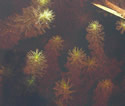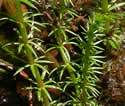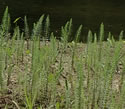Hippuris vulgaris (Mare's Tail)
| Also known as: | Common Mare's-tail |
|---|---|
| Genus: | Hippuris |
| Family: | Plantaginaceae (Plantain) |
| Life cycle: | perennial |
| Origin: | native |
| Habitat: | part shade, sun; wet; rivers, streams, lakes, marshes, wet ditches |
| Bloom season: | June - August |
| Plant height: | 4 to 24 inches |
| Wetland Indicator Status: | GP: OBL MW: OBL NCNE: OBL |
| MN county distribution (click map to enlarge): |  |
| National distribution (click map to enlarge): |  |
Pick an image for a larger view. See the glossary for icon descriptions.
Detailed Information
Flower: 

![[photo of flowers ©Dr. Dean Wm. Taylor]](/udata/r9ndp23q/contrib/hippuris-vulgaris-1645dwt-t.jpg) Whorls of tiny flowers at the leaf nodes all along the emersed part of the stem, with a single flower in each leaf axil. Flowers are petal-less, green to purplish, oval, about 1 mm long, either male with a single purplish stamen, female with a single thread-like style, or perfect with both a style and a stamen.
Whorls of tiny flowers at the leaf nodes all along the emersed part of the stem, with a single flower in each leaf axil. Flowers are petal-less, green to purplish, oval, about 1 mm long, either male with a single purplish stamen, female with a single thread-like style, or perfect with both a style and a stamen.
Leaves and stems: 

 Plants are usually at least partially submersed, though may be wholly emersed or less often wholly submersed. Emersed leaves are lance-linear, up to 1 inch long, fairly stiff, whorled around the stem in groups of 8 to 12, toothless, hairless, pointed at the tip, stalkless, usually widely spreading and often slightly curved. Submersed leaves are similar in shape but are limp, much longer, typically with 12 to 16 in a whorl and the whorls densely crowded on the stem.
Plants are usually at least partially submersed, though may be wholly emersed or less often wholly submersed. Emersed leaves are lance-linear, up to 1 inch long, fairly stiff, whorled around the stem in groups of 8 to 12, toothless, hairless, pointed at the tip, stalkless, usually widely spreading and often slightly curved. Submersed leaves are similar in shape but are limp, much longer, typically with 12 to 16 in a whorl and the whorls densely crowded on the stem.
![[photo of creeping stems]](/udata/r9ndp23q/other/hippuris-vulgaris-mares-tail_0719_114651-t.jpg) Stems are stout, hollow, unbranched, hairless, often prostrate from the base and rooting at the nodes. Emersed stems become erect and stiff while submersed stems are limp. Plants can grow in water up to 10 feet deep, and form large colonies from creeping rhizomes, the older part of the stem dying off after new growth establishes. Submersed plants spread vegetatively, while emersed plants also reproduce by seed.
Stems are stout, hollow, unbranched, hairless, often prostrate from the base and rooting at the nodes. Emersed stems become erect and stiff while submersed stems are limp. Plants can grow in water up to 10 feet deep, and form large colonies from creeping rhizomes, the older part of the stem dying off after new growth establishes. Submersed plants spread vegetatively, while emersed plants also reproduce by seed.
Fruit: 
![[photo of fruit]](/udata/r9ndp23q/pd/hippuris-vulgaris-071917-5-t.jpg) Fruit is a 1-seeded oval capsule 1.5 to 3 mm long. Seeds are oval-elliptic and smooth.
Fruit is a 1-seeded oval capsule 1.5 to 3 mm long. Seeds are oval-elliptic and smooth.
Notes:
Mare's Tail is a circumpolar species present in both North America and in northern Europe and Asia, found in the slow moving or stagnant waters of rivers, lakes, ditches and marshes, and on receding shores in sandy, gravelly or mucky soil. At first glance land-locked plants may resemble a Clubmoss, which is a non-flowering plant that reproduces by spores. Submersed plants vaguely resemble some other aquatics with narrow, whorled leaves, but Mare's Tail is distinguished by the stout, hollow, unbranched stems arising from a rhizome; simple, unlobed, limp leaves in whorls of up to 16; the whorls crowded on the stem. If there are emergent leaves, the shorter, stiffer leaves and whorls of flowers or fruits further distinguish Mare's Tail.
Native Plant Nurseries, Restoration and Landscaping Services ↓
More photos
 Mare's Tail plants
Mare's Tail plants emersed Mare's Tail plants
emersed Mare's Tail plants submersed Mare's Tail plants
submersed Mare's Tail plants Mare's Tail in a wet ditch with Cattails
Mare's Tail in a wet ditch with Cattails Mare's Tail on a mucky shore
Mare's Tail on a mucky shore Mare's Tail on a sandbar along the Mississippi River
Mare's Tail on a sandbar along the Mississippi River more leaves, and flowers past bloom
more leaves, and flowers past bloom submersed leaves are longer and more lax than emersed
submersed leaves are longer and more lax than emersed close-up of fruit
close-up of fruit
Photos by K. Chayka taken in Itasca County. Photos courtesy Peter M. Dziuk taken in Itasca and Lake counties. Hippuris vulgaris flowers by Dr. Dean Wm. Taylor used under CC BY-NC-SA 3.0.
Comments
Have you seen this plant in Minnesota, or have any other comments about it?






